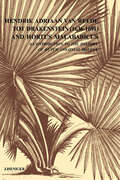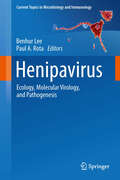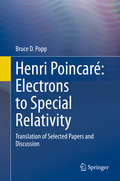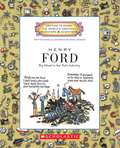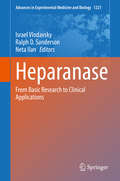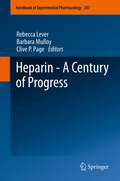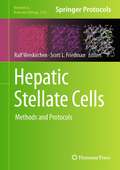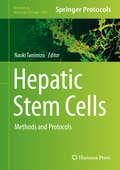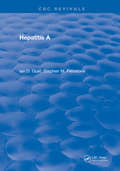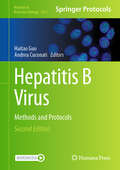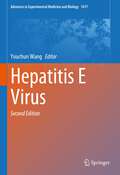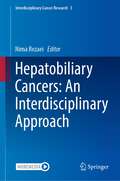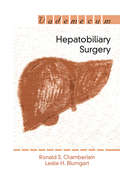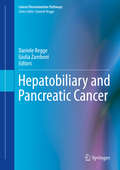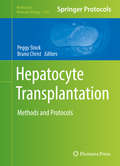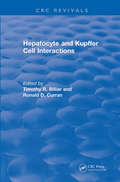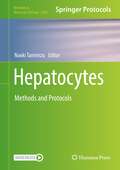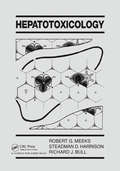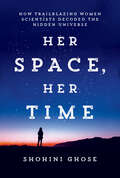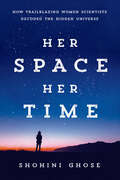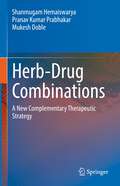- Table View
- List View
Hendrik Adriaan Van Reed Tot Drakestein 1636-1691 and Hortus, Malabaricus
by J. HenigerThis text is a reference work for botanists studying the flora of South Asia. As commander of Malabar, van Reed was responsible for compiling the Hortus Malabaricus, a major publication of the flora and medical use of plants.
Henipavirus
by Benhur Lee Paul A. RotaHenipaviruses form a new genus of emerging paramyxoviruses that are the deadliest human pathogens within the Paramyxoviridae family. This volume deals with the many facets of henipavirus biology, and covers our current understanding regarding the ecology, molecular virology, and pathogenesis of henipavirus infections. It is an international effort written by a multidisciplinary panel of experts at the front lines of research into this lethal emerging group of paramyxoviruses. The first section introduces the epidemiology and ecology of Nipah and Hendra viruses in their respective endemic areas, including a first-hand account of the discovery of Nipah virus during its initial outbreak in Malaysia; the next section documents the molecular virology of henipaviruses, and the substantial advances made towards understanding the unique features of henipavirus entry and tropism; and this is followed by accounts of the clinical and pathologic features of henipavirus infections in their human and naturally infected animal hosts. The next sections on pathogenesis provide a comprehensive reference on how henipaviruses counteract the innate immune system, and the relevant pathogenic features in animal challenge models developed to test potential therapeutic strategies. The final sections describe our current and future capabilities for diagnosis and control, including an account of potentially effective immunization strategies that are currently being tested. This book will not only serve as a useful reference for the henipavirus field; it will be useful to basic and animal virologists, ecologists, epidemiologists, physicians, and others interested in emerging infectious viral diseases, as it showcases the multidisciplinary efforts required to understand the genesis, spread and hopefully, control, of a group of lethal emerging zoonotic pathogens.
Henri Poincaré: Translation of Selected Papers and Discussion
by Bruce D PoppProduced by an award-winning translator of Henri Poincaré, this book contains translations of several seminal articles by Poincaré and discusses the experimental and theoretical investigations of electrons that form their context. In the 1950s, a dispute ignited about the origin of the theory of special relativity and thrust considerable notoriety on a paper written by Henri Poincaré in 1905. Accordingly, Part I presents the relevant translations of Poincaré’s work showing that radiation carries momentum and the covariance of the equations of electrodynamics, the continuity equation for charge, and the spacetime interval. Part II then discusses investigations by Thomson, Becquerel, and Kaufmann of electrons in diverse contexts; contributions of Abraham, Lorentz and Poincaré to a theory of electrons that includes Lorentz transformations and explains the dependence of mass on velocity; and finally, Poincaré’s exploration of the relativity principle, electron stability, and gravitation while rejecting absolute motion (ether) and an electromagnetic origin of mass. Part III contains the 1904 article by H. A. Lorentz presenting his transformations.This book will be a fascinating read to graduate-level students, physicists, and science historians who are interested in the development of electrodynamics and the classical, relativistic theory of electrons at the beginning of the 20th century.
Henry David Thoreau for Kids: His Life and Ideas, with 21 Activities
by Corinne SmithHands-on nature activities for the budding transcendentalist Author and naturalist Henry David Thoreau is best known for living two years along the shores of Walden Pond in Concord, Massachusetts. He is also known for spending a night in jail for nonpayment of taxes, which he discussed in the influential essay "Civil Disobedience." More than 150 years later, people are still inspired by his thoughtful words about individual rights, social justice, and nature. His detailed plant observations have even proven to be a useful record for 21st-century botanists. Henry David Thoreau for Kids chronicles the short but influential life of this remarkable thinker. In addition to learning about Thoreau's contributions to our culture, young readers will participate in engaging, hands-on projects that bring his ideas to life. Activities include building a model of the Walden cabin, keeping a daily journal, planting a garden, baking trail-bread cakes, going on a half-day hike, and starting a rock collection. The book also includes a time line and list of resources--books, websites, and places to visit--which offer even more opportunities to connect with this fascinating man.
Henry Ford for Kids: His Life and Ideas, with 21 Activities (For Kids series #61)
by Ronald A. ReisAn in-depth and realistic portrait of the man who "put America on wheels" Detailing Henry Ford's childhood as a precocious farm-boy mechanic, his revolutionary labor and production ideas, and the lasting legacy of his widespread philanthropy, author Ronald A. Reis also does not shy away from his eccentricities. The issues that stirred controversy are discussed, such as the industrialist's anti-Semitic views and his pacifist beliefs. Packed with historic photos and illuminating sidebars, Henry Ford for Kids brings the turn of the 20th century to life, touching on related topics such as the popularity of "auto polo," the Great War, and the life of industrial architect Albert Kahn. Twenty-one hands-on activities encourage budding innovators to apply engineering and production ideas and learn more about the era as kids will build a lemon-powered battery, make a moving assembly line, learn to dance the waltz, design an automobile dashboard, and much more.
Henry Ford: Big Wheel in the Auto Industry
by Mike VeneziaThis colorful business giant didn't just revolutionize the way the world travels he changed the way it works! Take a ride in the fast lane with Henry Ford, father of the automobile, the assembly line, and 20th-century American industry.
Henry Ford: Young Man with Ideas (Childhood of Famous Americans Series)
by Hazel B. Aird Catherine RuddimanA fictionalized biography of the early life of the American automotive industrialist who founded the Ford Motor Company and pioneered in assembly-line methods of mass production.
Heparanase: From Basic Research to Clinical Applications (Advances in Experimental Medicine and Biology #1221)
by Israel Vlodavsky Ralph D. Sanderson Neta IlanWritten by internationally recognized leaders in Heparanase biology, the book’s eight chapters offer an opportunity for scientists, clinicians and advanced students in cell biology, tumor biology and oncology to obtain a comprehensive understanding of Heparanase’s multifaceted activities in cancer, inflammation, diabetes and other diseases, as well as its related clinical applications. Proteases and their involvement in cancer progression have been well addressed and documented; however, the emerging premise presented within this book is that Heparanase is a master regulator of aggressive cancer phenotypes and crosstalk with the tumor microenvironment. This endoglycosidase contributes to tumor-mediated remodeling of the extracellular matrix and cell surfaces, augmenting the bioavailability of pro-tumorigenic and pro-inflammatory growth factors and cytokines that are bound to Heparan sulfate. Compelling evidence ties Heparanase with all steps of tumor progression including tumor initiation, growth, angiogenesis, metastasis, and chemoresistance, supporting the notion that Heparanase is an important contributor to the poor outcome of cancer patients and a validated target for therapy. Unlike Heparanase, heparanase-2, a close homolog of Heparanase, lacks enzymatic activity, inhibits Heparanase, and regulates selected genes that promote normal differentiation and tumor suppression. Written by internationally recognized leaders in Heparanase biology, this volume presents a comprehensive understanding of Heparanase’s multifaceted activities in cancer, inflammation, diabetes and other diseases, as well as its related clinical applications to scientists, clinicians and advanced students in cell biology, tumor biology and oncology.
Heparin - A Century of Progress
by Barbara Mulloy Rebecca Lever Clive P. PageHeparins remain amongst the most commonly used drugs in clinical practice. Almost 100 years have passed since the initial discovery of this complex substance and, during this time, understanding of the nature and uses of heparin and related molecules has grown dramatically. The aim of this volume is to summarise the developments that have led to the current status of both heparins as drugs and the field of heparin research, with a focus on the particularly rapid progress that has been made over the past three decades. Individual sections are dedicated to the nature of heparin as a biological molecule, the current approaches and techniques that are used to ensure the safety and reliability of heparin as a medicine, the clinical pharmacology of heparin as an anticoagulant drug, effects and potential applications of heparin aside of those involving haemostasis and, finally, the nature and potential uses of heparin-like materials from both natural and synthetic sources.
Hepatic Stellate Cells: Methods and Protocols (Methods in Molecular Biology #2669)
by Scott L. Friedman Ralf WeiskirchenThis detailed volume explores hepatic stellate cells, which have become a spotlight of liver cell biology due to their pleiotropic functions that extend well beyond extracellular matrix production to pivotal roles in hepatic homeostasis, immunity, and metabolism. The book features methods to isolate, evaluate, and manipulate this cell type in an effort to elucidate hepatic biology and establish prospects for treating disease. Written for the highly successful Methods in Molecular Biology series, chapters include introductions to their respective topics, lists of the necessary materials and reagents, step-by-step and readily reproducible laboratory protocols, as well as tips on troubleshooting and avoiding known pitfalls. Authoritative and practical, Hepatic Stellate Cells: Methods and Protocols serves as an ideal aid to help researchers accelerate the outstanding science that has steadily unveiled the mysteries of stellate cell biology and their role in disease.
Hepatic Stem Cells: Methods and Protocols (Methods in Molecular Biology #1905)
by Naoki TanimizuThis volume looks at the liver’s epithelial cells—hepatocytes and cholangiocytes—and their progenitors. This book is divided into five parts: isolation of progenitor cells; characterization of liver progenitors in vivo; generation of hepatocytes, cholangiocytes, and their progenitors; reconstitution of liver tissue structures; and liver injury models. The chapters in this book cover topics such as expansion of bipotential liver stem/progenitor cells (LPCs) from fetal and neonatal liver; identifying progenitor cells involved in liver regeneration in vivo; methods for generating hepatocytes and cholangiocytes from multiple cellular sources; 3D tissue structures ex vivo; and resolving hepatic fibrosis by bone marrow transplantation. Written in the highly successful Methods in Molecular Biology series format, chapters include introductions to their respective topics, lists of the necessary materials and reagents, step-by-step, readily reproducible laboratory protocols, and tips on troubleshooting and avoiding known pitfalls.Cutting-edge and thorough, Hepatic Stem Cells: Methods and Protocols is a valuable resource to help researchers understand the current theories used to study hepatic stem/progenitor cells, and aid them in performing experiments related to liver biology and pathophysiology.
Hepatitis A: A Virus
by Ian D. GustIn the present volume, current knowledge of Hepatitis A is reviewed and the sequence of events, that led to each of the major advances in the field, traced.
Hepatitis B Virus: Methods and Protocols (Methods in Molecular Biology #2837)
by Haitao Guo Andrea CuconatiThis detailed new edition collects state-of-the-art methods in the fields of hepatitis B virus (HBV) molecular biology and immunology. The book features techniques for cell culture, epigenetic regulation of cccDNA transcription, epitranscriptomic modification of HBV RNA, HBV pregenomic RNA and subviral particle morphogenesis, and much more. Written for the highly successful Methods in Molecular Biology series, chapters include introductions to their respective topics, lists of the necessary materials and reagents, step-by-step and readily reproducible laboratory protocols, and tips on troubleshooting and avoiding known pitfalls. Authoritative and practical, Hepatitis B Virus: Methods and Protocols, Second Edition serves as an ideal guide for researchers pursuing a cure for this chronic disease.
Hepatitis E Virus (Advances in Experimental Medicine and Biology #1417)
by Youchun WangThis book systematically and comprehensively discusses the biological, epidemiological, and clinical characteristics of the hepatitis E virus (HEV). It presents current knowledge of HEV and explores experimental methods, treatment, and prevention of HEV. First identified in the 1980s and cloned in 1990, HEV is the causative agent of hepatitis E, which mainly occurs in developing regions, such as Southeast Asia, the Middle East, and Africa, and significantly affects the health of the people in these areas. It is estimated that a third of the world’s population has been infected with HEV, which is transmitted via the fecal-oral route and can infect both humans and animals. In the second edition, new chapters are added to demonstrate the lifecycle, morphogenesis, and stem cell culture of hepatitis E virus. Although research on hepatitis E virus has made progress recently, there are still some problems that have not been solved. Those problems are discussed in this edition, which would be helpful for researchers to understand the problems on hepatitis E virus that they have faced. Meanwhile, the epidemiology, transmission, genetic evolution, animal models, treatment, and others in the related chapters of the first version were also updated according to the most recent research progress. The book provides an overview of HEV from benchside to bedside. It is a valuable resource for researchers in the field and those in the pharmaceutical industry developing HEV vaccines, as well as physicians involved in identifying and treating those infected with the virus.
Hepatobiliary Cancers: An Interdisciplinary Approach (Interdisciplinary Cancer Research #3)
by Nima RezaeiHepatobiliary cancers, including hepatocellular carcinoma and biliary tract cancers, have high rate of mortality and low survival rate. The third volume of the “Interdisciplinary Cancer Research” series, entitled “Hepatobiliary Cancers: An Interdisciplinary Approach” publishes comprehensive volumes on mechanisms of hepatobiliary cancers and therapeutic modalities and presents the most updated and peer-reviewed chapters on hepatobiliary cancers. This interdisciplinary series is of special value to researchers working on cell biology, immunology, biochemistry, genetics, and practitioners working on oncology and gastroenterology. This is the main concept of Cancer Immunology Project (CIP), which is a part of Universal Scientific Education and Research Network (USERN). This interdisciplinary book will be of special value for researchers, oncologists, and gastroenterologists who wish to extend their knowledge on hepatobiliary cancers.
Hepatobiliary Surgery
by Ronald S. ChamberlainThis book is written as a reference and guidebook for practicing surgeons, gastroenterologists, and interventional radiologists with an interest in hepatobiliary diseases. It presents a strategy to enhance surgeons practice and the care of patients.
Hepatobiliary and Pancreatic Cancer (Cancer Dissemination Pathways Ser.)
by Giulia Zamboni Daniele ReggeThis book describes the pathways of dissemination of primary liver, biliary, and pancreatic neoplasms and proposes a practical and clinically driven approach to their imaging. The typical dissemination pathways for hepatocellular carcinoma, cholangiocarcinoma, exocrine pancreatic carcinoma, and neuroendocrine pancreatic tumors are systematically reviewed, and more unusual pathways are also documented. The content is presented in an extremely schematic way, with numerous high-quality graphical illustrations and multimodality images (US, CT, MRI, and PET) that are accompanied by clear explanatory text. The clinical significance of findings and potential therapeutic options are explained whenever appropriate. In addition, relevant background information is provided on the role of morphopathological drivers of cancer spread and anatomy.
Hepatocyte Transplantation
by Bruno Christ Peggy StockThis volume features up-to-date protocols for the isolation, preservation, and validation of various cell sources comprising large and small animal models, examining the impact of cell transplantation on acute and chronic liver diseases. Hepatocyte Transplantation: Methods and Protocols guides readers through laboratory protocols for the generation of humanized livers for the assessment of biological actions in vivo and techniques to monitor cell engraftment after cell transplantation in vivo are described and procedures for computational analyses of hepatocyte transplantation. Written in the highly successful Methods in Molecular Biology series format, chapters include introductions to their respective topics, lists of the necessary materials and reagents, step-by-step, readily reproducible laboratory protocols, and tips on troubleshooting and avoiding known pitfalls. Comprehensive and practical, Hepatocyte Transplantation: Methods and Protocols is an essential resource for researchers and clinicians to assess the biological as well as the therapeutic potential of hepatocyte transplantation.
Hepatocyte and Kupffer Cell Interactions (CRC Press Revivals)
by Timothy R. Billiar Ronald D. CurranHepatocyte and Kupffer Cell Interactions presents a comprehensive discussion of historical and recent information regarding this diverse field of research. The role of Kupffer cells and hepatoctyes in normal physiology, nonseptic pathological states, and in sepsis is examined. Microanatomy and methods of experimental study are covered as well. In each of the book's chapters, the role of the Kupffer cell and hepatocyte interaction is placed in context with information on particular liver functions or disease states. Hepatocyte and Kupffer Cell Interactions is an essential reference for leukocyte specialists, gastroenterologists, immunologists, and other researchers working in this fascinating field.
Hepatocytes
by Patrick MaurelHepatocytes account for approximately 80% of the liver mass and play a significant role in various aspects of liver physiopathology, exhibiting unrivaled complexity and diversity of functions. In Hepatocytes: Methods and Protocols, expert researchers provide the reader with methods, technical protocols, and review chapters focusing on selected areas of hepatocyte biology including isolation, culture, differentiation and stem cells, and hepatocyte use in clinical, basic, and applied research. With a specific emphasis on human hepatocytes, the volume presents chapters covering subjects including hepatocyte culture models, cryopreservation methods, differentiation assessment, liver ontogenesis, production of hepatocytes from stem cells, drug/xenobiotic metabolism, toxicity and transport, bile acid and blood coagulation factor production, infection by HBV and HCV, humanized animals, biortificial liver devices, hepatocyte transplantation. As a volume in the highly successful Methods in Molecular BiologyTM series, protocol chapters include brief introductions to their respective topics, lists of the necessary materials and reagents, step-by-step, readily reproducible laboratory protocols, and notes on troubleshooting and avoiding known pitfalls. Comprehensive and cutting-edge, Hepatocytes: Methods and Protocols will be useful to all those who are currently using or planning to use human, or animal, hepatocytes to investigate any aspect of liver physiopathology or who are interested in liver development or liver stem cells and liver biotherapy.
Hepatocytes: Methods and Protocols (Methods in Molecular Biology #2544)
by Naoki TanimizuThis volume details experimental protocols to study structure and function of hepatocytes in vivo and in vitro, and for characterizing heterogeneity and plasticity of hepatocytes in healthy and in injured liver. Chapters guide readers through separating hepatocyte subfractions, characterizing the heterogeneity, novel culture systems, hepatocyte-like cells from human pluripotent stem cells, analyzing drug metabolism, monitoring protein sorting, manipulating gene expression, and methods for expanding primary hepatoblastoma and identifying hepatocellular carcinoma subtypes. Written in the format of the highly successful Methods in Molecular Biology series, each chapter includes an introduction to the topic, lists necessary materials and reagents, includes tips on troubleshooting and known pitfalls, and step-by-step, readily reproducible protocols. Authoritative and cutting-edge, Hepatocytes: Methods and Protocols aims to provide techniques to further understand molecular mechanisms involved in the regulating hepatocyte functions and underlying liver diseases.
Hepatotoxicology
by Robert G. Meeks Steadman HarrisonThis book is destined to serve as a classic reference source to which researchers can turn for a historical perspective and basic information on the physiology, biochemistry, and pathology of the liver. Major areas covered in the book include histological organization, classification of chemical-induced injury, stages of cellular injury, and xenobiotic metabolism. Chapters discussing the use of biochemical methods to determine liver damage, the effects of various chemical agents of the liver, and hepatocarcinogenesis are also presented. Toxicologists, physiologists, physicians, biochemists, industrial hygienists, and others interested in the effects of chemical agents on the structure and function will find this book to be an indispensable source of information.
Her Space, Her Time: How Trailblazing Women Scientists Decoded the Hidden Universe
by Shohini GhoseAn exciting new title in the vein of Hidden Figures, which tells the inspiring stories of long-overlooked women physicists and astronomers who discovered the fundamental rules of the universe and reshaped the rules of society.Women physicists and astronomers from around the world have transformed science and society, but the critical roles they played in their fields are not always well-sung. Her Space, Her Time, authored by award-winning quantum physicist Shohini Ghose, brings together the stories of these remarkable women to celebrate their indelible scientific contributions. In each chapter of the book, Ghose explores a scientific topic and explains how the women featured in that chapter revolutionized that area of physics and astronomy. In doing so, she also addresses particular aspects of women&’s experiences in physics and astronomy: in the chapter on time, for instance, we learn of Henrietta Leavitt and Margaret Burbidge, who helped discover the big bang and the cosmic calendar; in the chapter on space exploration, we learn of Anigaduwagi (Cherokee) aerospace scientist Mary Golda Ross, who helped make the Moon landings possible; and in the chapter on subatomic particles, we learn of Marietta Blau, Hertha Wambacher, and Bibha Chowdhuri, who contributed to the discovery of the building blocks of the universe, and, in doing so, played a crucial role in determining who gets to do physics today.Engaging, accessible, and timely, Her Space, Her Time is a collective story of scientific innovation, inspirational leadership, and overcoming invisibility that will leave a lasting impression on any reader curious about the rule-breakers and trendsetters who illuminated our understanding of the universe.Some of the featured women scientists in the book Williamina FlemingAnnie Jump CannonCecilia Payne-GaposchkinAntonia MauryHenrietta LeavittMargaret BurbidgeMary Golda RossDilhan EryurtClaudia AlexanderJoyce NeighborsNavajo women of Shiprock Harriet BrooksMarie CurieLise MeitnerMarietta BlauHertha WambacherBibha ChowdhuriWu Chien-ShiungWomen of the Manhattan ProjectVera Rubin
Her Space, Her Time: How Trailblazing Women Scientists Decoded the Hidden Universe
by Shohini GhoseOne of Canada's leading physicists celebrates the many, groundbreaking women scientists who came before her—unsung explorers of the cosmos who both discovered the fundamental rules of the universe and challenged social rules, yet whose names remain largely unknown to us.Her Space, Her Time shares the stories of women in physics and astronomy whose work expanded scientific understanding yet whose accomplishments are often overlooked—creating a thrilling account of scientific discovery, inspirational leadership and persistence in the face of overwhelming challenges. In shaping her narrative around the science that fascinated them and the social context in which they worked, award-winning quantum physicist Shohini Ghose champions these remarkable women&’s contributions, which loom even larger given the misogyny and discrimination they faced. Ghose's canvas stretches from the 19th century to the present and includes many women whose work led to Nobel Prizes that were ultimately awarded to men. Among this list of impressive scientists: Henrietta Leavitt and Margaret Burbidge, who helped discover the big bang and the cosmic calendar; Anigaduwagi (Cherokee) aerospace scientist Mary Golda Ross, who helped make the Moon landings possible; atom splitter Lise Meitner; Bibha Chowdhuri, who discovered two fundamental particles; and Harriet Brooks—a Canadian physicist whose impact on radioactivity research was compared to Marie Curie&’s, but who felt that marriage, not science, was the choice she had to make. Engaging and inspirational, Her Space, Her Time is threaded through with Ghose's own experiences in science—women in STEM still face the same kind of challenges her subjects encountered—and driven by the imperative to make the invisible visible, ensuring that the names of these women who pursued science against all odds will never be forgotten.
Herb-Drug Combinations: A New Complementary Therapeutic Strategy
by Mukesh Doble Shanmugam Hemaiswarya Pranav Kumar PrabhakarPlant extracts or their pure natural constituents have been used traditionally for thousands of years for treating diseases with considerable success in India and other Asian countries. In addition, they have also been used as complements or supplements with conventional medicine. This book discusses the latest research in the application of combination therapy, namely herbs and drugs, in the treatment of a range of communicable and non-communicable diseases to achieve a synergistic effect. This synergy may help in reducing the amount of drug, its toxicity, side effects, and development of resistance as well as improve its efficacy. The book also discusses the pharmacodynamic and pharmacokinetic parameters, experimental tools to determine the impact of combination, computational approaches to identify synergy, statistical analysis of data, and clinical and regulatory issues. The book is useful for researchers in the fields of pharmacology, pharmacy and medicinal chemistry and those working in pharmaceutical and nutraceutical industries. This book could open up new strategies to focus on multiple targets to combat complex diseases unlike the single targeted drugs that are being currently marketed by the pharmaceuticals industries.
